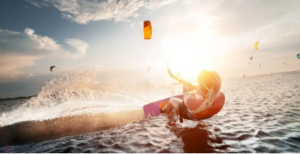Kitesurfing is an intensely physical sport. To succeed at kitesurfing, you must balance three opposing forces – gravity, the pull of the kite and the kick from your board.
Kitesurfers are connected to their kites by two to five “flying lines”, known as “control bars”, that connect them. Using these bars, riders can steer and manoeuvre the kite with precision.
Wind
 Wind is the cornerstone of kitesurfing and can make or break your practice. Your kite can only fly and move across the water with enough breeze from convecting warm air; its strength may range from gusty gusts to light breezes with variable characteristics.
Wind is the cornerstone of kitesurfing and can make or break your practice. Your kite can only fly and move across the water with enough breeze from convecting warm air; its strength may range from gusty gusts to light breezes with variable characteristics.
The wind force is generally at its strongest downwind of a kiteboarder and its lowest at ground level; this area is known as the power window. Kite manufacturers provide range charts detailing the minimum wind speeds required to get your kite aloft.
Kitesurfing is an easy sport to pick up; all it requires is a moderate breeze to begin kitesurfing. But controlling the kite requires full body control – arms, legs, abs and back muscles all working to master this activity! Kitesurfing also has numerous health benefits, including improving balance, strength and stamina as you ride across the waves on a board.
Kite
Acclimatizing to kiteboarding on land takes some practice. But for many, the biggest obstacle lies in actually taking the leap and signing up for a lesson to get out on the water.
Once they settle into an ideal riding position, riders can experience the amazing sensation of breaking free from Earth’s gravitational pull (and looking like an intimidating badass while doing so!). Newtonian mechanics based on mass flow rate explains this phenomenon.
Performance depends heavily on its ability to fly within its wind window – an area from one edge of its visual field over the horizon to its opposite and directly overhead – as this determines where and how a kite flies. Being outside this range quickly becomes uncontrollable and may stall, which is why beginners should use trainer kits until they feel secure enough to move on to more advanced kiting techniques.
Board
Board designs vary in shape and size to meet different kiting conditions, with bidirectional twin-tip boards similar to wakeboards or directional surfboards used for riding waves being common options. As kiters advance, they often opt for larger boards, which require less power from their kite to reach maximum speed; freeride riders, however, usually prefer smaller twin-tip boards with excellent relaunch and hang times to perform advanced tricks.
Wind measurements in terms of miles per hour, feet per second or meters per second vary significantly in how they affect riders due to movement and location relative to wind windows. To increase wind feel by riding faster or at an obtuse angle into it.
Kiting requires having some form of buoyancy aid, such as a wetsuit or PFD (personal flotation device). It will keep you afloat after crashes, catch your breath after landing back onto your board after becoming unhooked from your kite, or return safely back home should something go amiss and lose control.
Safety
Kitesurfing is an exhilarating sport that uses all aspects of one’s body to control a kite on the water via a light board. In enjoying its thrills safely and responsibly, precautionary measures should be observed at all times.
Safety measures for kitesurfers include wearing a light life jacket and using floating kitesurfing ropes and bar floats. A beginner may instinctively grab their bar, which could result in lines becoming entangled around underwater obstructions or becoming hooked in them, leading to dangerous results.
Kitesurfing is an extreme water sport and requires a certain amount of fitness to learn. It also requires a good level of swimming or the ability to use a buoyancy aid to stay afloat. It is necessary because the power of a kite can push you downwind and can cause injury or drowning in the event of a crash.
It is always best to start kite surfing at a qualified kite surf school. It will help you avoid dangerous situations and make your learning experience safer. It’s like driving a car; you need to learn the basics before you can safely and confidently go out on your own.